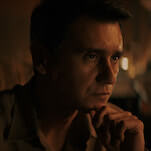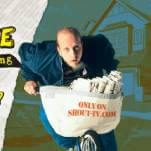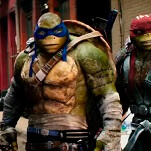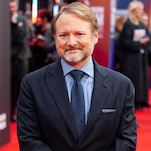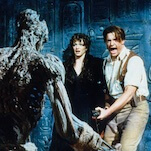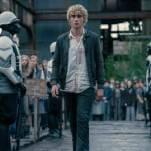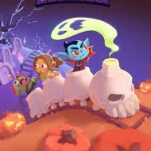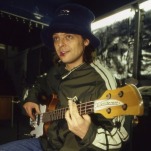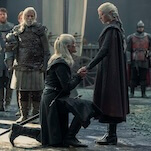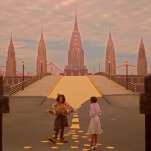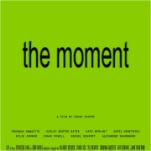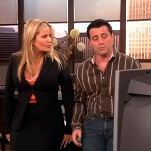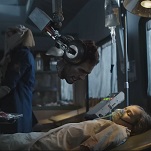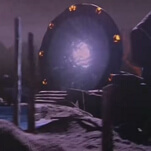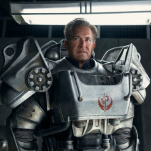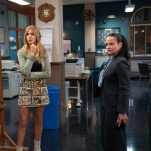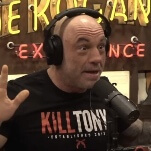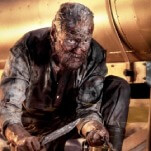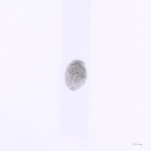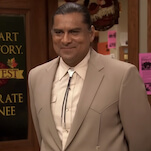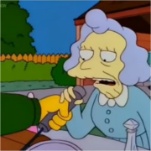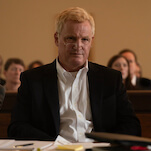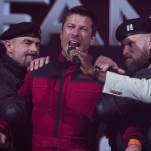Got a light? The A.V. Club reacts to the boldest Twin Peaks yet
I remember watching Twin Peaks for the first time seven or eight years ago, and thinking that it wasn’t as strange as I’d been led to believe. Yes, Cooper’s dream, Maddie’s death, and the trapping of Josie’s soul in a wooden knob lived up to the hype, but most of what surrounds those scenes plays by TV convention—when those conventions aren’t being warped by Twin Peaks. Having previously absorbed the show’s subtler advancements by osmosis—the serialized mysteries, the surrealism, the atmosphere that seeped out of the TV into my Game Boy—my uninformed impression of Twin Peaks was instead made up of the larger pieces of Lynchian flotsam and jetsam that lingered in the public imagination. It was a version of the show that took place entirely in the RR and Black Lodge, where the most eccentric denizens of Twin Peaks flummoxed and beguiled Homer Simpson and Cookie Monster, and there are always accurate recreations of Angelo Badalamenti’s instrumental score in the air.
I love Twin Peaks regardless, but I think there’s been a part of me that’s been holding out for something like “Part 8” of The Return ever since I first saw Homer see The Giant waltzing with a horse beneath the traffic light. This was, without a doubt, one of the most flummoxing and beguiling hours of TV I’ve ever seen—and one of the scariest, too. And although I’m reluctant to embrace anything that tries to put the mythology of the show in more concrete terms, as Sean reminded me this morning, there’s nothing really concrete about Frank Silva’s face floating in a gelatinous orb barfed up by a shadow.
Let’s resist the temptation to analyze and simply react to this episode, whose imagery is seared in my mind this afternoon. The Trinity test, apocalypse by way of Stanley Kubrick and Stan Brakhage. The Woodsman, stalking through the New Mexico desert like the star of an atomic-anxiety creature feature where this (and this, and also this) is the director’s idea of a creature. That horrible, awful, no-good insect/reptile hybrid crawling into Tikaeni Faircrest’s mouth. I’ll cop to drifting off during the interlude with The Giant and Senorita Dido, but I was as fixated on and horrified by the explosion footage as Carel Struycken’s still-unnamed-in-the-credits character. I’m the type of doofus who’ll pony up for 2001: A Space Odyssey in 70mm just to see the stargate sequence, so maybe I’m not to be trusted here. But way back when, I started watching Twin Peaks expecting more of this type of non-narrative, bizarre material. To quote one of the great thinkers of our time: Brilliant. I have absolutely no idea what’s going on.
Erik, just reacting to a David Lynch project without analyzing at the same time is almost an impossibility for me, despite your urging. The director’s work courts psychoanalysis, even if it’s just free association of the kind you perform when you (very appropriately) make comparisons with Brakhage and Kubrick, and then talk about what sequence most elicited a horrified reaction from you. Because sure, there might not be concrete answers here, but this is the closest I’ve seen Lynch come to offering up some definitive ones in this series, and honestly, I’m not sure it even makes sense to pretend it’s more ambiguous than it is.
This was essentially an origin story, albeit the most free-floating and elliptical origin story of all time. It took an act of destruction unparalleled in human history—the first testing of the atomic bomb—to unleash a far more elusive destructive force into this reality. Whether the nuclear blast created Bob or simply allowed for his entry into this dimension, it’d be hard to argue that the sequence wasn’t giving us the birth of Twin Peaks’ malevolent figure of evil. Especially if you take into account the original series itself (please enjoy going down this rabbit hole with me): Mike’s monologue from way back when name-checks the store that gets destroyed as his original home. “We lived among the people—I think you say, ‘convenience store.’ We lived above it.” That would explain the strange and otherwise inexplicable scene where the mystery men arrive at the burning store, following the hypnotic explosion. I’ve been as vocal as anyone about the fact that much of the new season seems to be an excuse for Lynch to indulge whatever weird symbolic culs-de-sac he feels like strolling down, but there were visual cues here that directly linked these scenes to the old Twin Peaks mythology. Like most of Lynch’s work, they’re rewarding if you enjoy making those connections, yet they’re also not necessary to appreciate what he’s doing. This was entrancing stuff by any barometer—but for a diehard fan, that callback was exciting as hell.
Also, let’s take a moment to give respect to the decision to follow the surprise shooting, mystical blood-smearing, and rebirth of Doppel-Cooper with an abrupt cutaway from the story, in order to do a nearly wordless 40-minute flashback to a creation myth of a different kind. Bob has often been described as a parasite, and here, we get a very literal version of that, with the creepy reptile/insect creature crawling into a young woman’s mouth (could this be Sarah Palmer?) at the same time as the spirit version of Bob is floating into the world. We also get the Giant’s floating orb of energy, adorned with Laura Palmer’s image. Erik, you may have drifted during this sequence, but I was riveted by the Giant’s home, from the old-time jazz music to the big-screen replay of the nuclear blast’s fallout. And there haven’t been many scenes as unsettling as the Woodsman, lead avatar of all those dark figures, leaning in with his unlit cigarette, repeating, “Gotta light?” Sure, I could just let it wash over me without delving into speculation as to what it all means, but why would I, when there are so many signifiers just begging to be floated like a ball of Bob-energy? After all, Bob’s been with us for nearly 65 years, now—and this installment manages to pay off a number of allusions while still keeping his origin shrouded in mystery and confusion. That’s one hell of an achievement.
But most of all, even for a series where oddity and the confounding of standard television narrative and technique are par for the coffee-laden course, this was a Twin Peaks that challenged the very idea of what an episode of television can be. Lynch and others have referred to the return of the show as more like an 18-hour movie than a TV series, but really, it’s more like 18 mini-movies, each one united by a shared world and story, but roaming through numerous stylistic and framing devices, exploring the boundaries of the medium, and teasing at the edges of the entire edifice of Twin Peaks mythos. And of all the little worlds he’s delved into thus far, this one filled with billowing clouds, amorphous births, and menacing murderers is my favorite.
